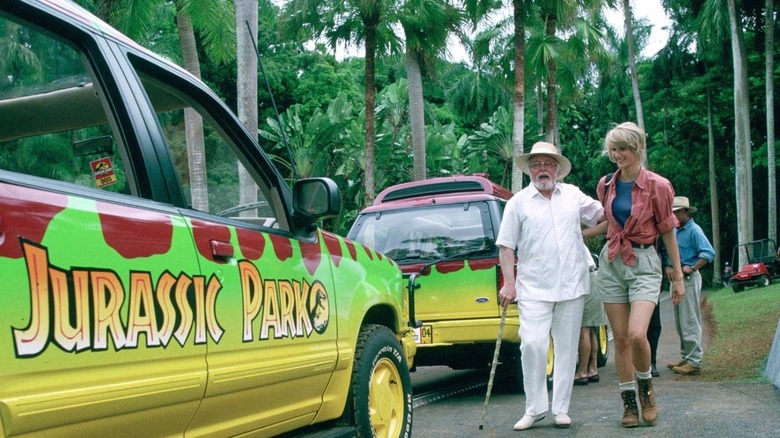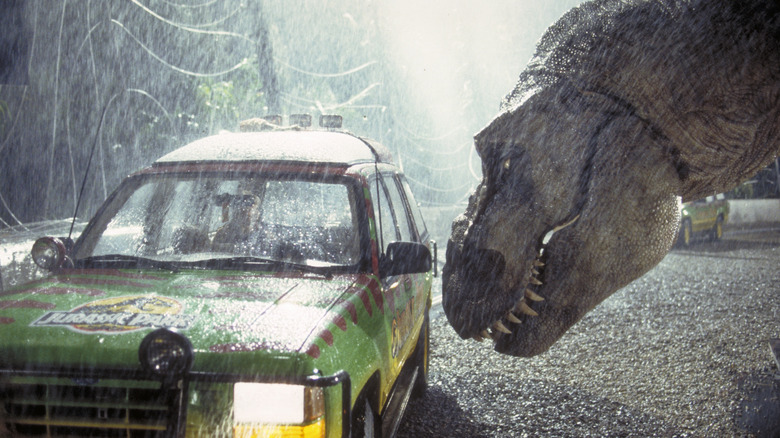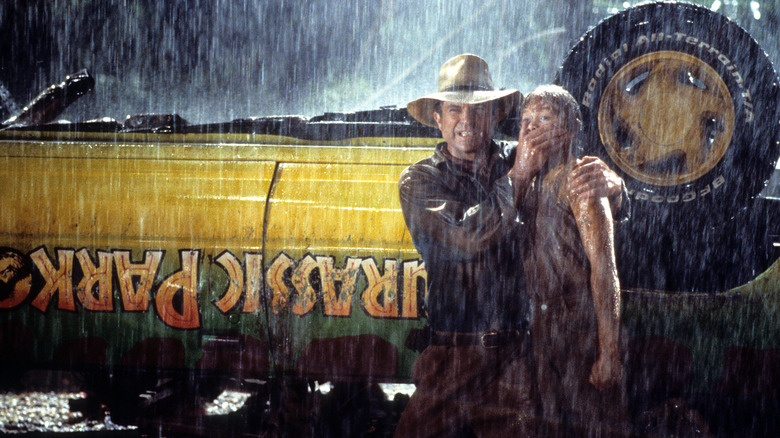Jurassic Park Had A Surprisingly Simple Solution To Self-Driving Cars
The term "movie magic" is thrown around an awful lot, but if there is a director out there who truly encapsulates that phrase, it is most likely Steven Spielberg, the man behind "Jaws" and "E.T." But one of his finest hours in terms of crafting true blue movie magic is 1993's "Jurassic Park," which brought dinosaurs to life on the big screen in a way that nobody ever imagined possible before that moment. The dinosaurs, though, were just one element of that cinematic magic at play, as a great deal of innovation was needed to make it feel like this prehistoric amusement park was real. One such example is the self-driving cars that guide guests around the park. This was, especially in 1993, a pretty amazing concept. The John Hammond character says he spared no expense, and it needed to look that way on film.
As for the cars themselves, they were crafted from a 1993 Ford Explorer, and the model's inclusion in "Jurassic Park" helped make the vehicle famous. But how is it that Spielberg and the filmmakers made it look like these cars were driving themselves? Actor Joseph Mazzello, who plays Tim Murphy in the movie shed some light on that mystery, and the answer is kind of amazing.
People were still driving the cars
Mazzello participated in a lengthy Q&A with IGN about the movie in April of 2020 and answered all manner of questions, providing insight into the making of "Jurassic Park" where and when he could. In responding to a question about scenes that were filmed that didn't end up in the final edit, Mazzello made a pretty interesting reveal about the self-driving cars we see in the park itself.
"There was an idea that, when the cars are driving themselves later in the movie, that we were going to be going over this land bridge ... Those cars were supposed to be 'driving themselves,' well in reality there's a guy in the trunk of the car with a little TV screen, you know, smaller than my iPad that I'm on right now, and he's hunched down on his side like this driving the Jeep, driving the cars, and that's how they're being driven. They're being driven by people in the cars in the trunk. And so when my dad saw that land bridge with, like, it's death on either side, there's no barriers, he was just like, 'We're not doing this one.' Like, no way no how."
That's right. These cars weren't self-driving in any way, shape, or form. As Mazzello tells it, there was someone hidden in the back of the car actually driving it, making it appear as though it was maneuvering effortlessly down a track. On one hand, it's deceptively simple to just have someone drive the car, but the logistical effort in getting a person to drive the car from the back as described is something else entirely. Again, movie magic. It's hard to imagine any viewers would have ever imagined that to be the case when watching the film.
Just one example of innovation in Jurassic Park
This is but just one of many, many examples of innovation employed by Spielberg and the team behind "Jurassic Park," including effects wizard Stan Winston. First and foremost, the film employed a groundbreaking combination of animatronic dinosaurs and never-before-seen amounts of CGI to bring the beasts to life on screen. Because the film was so successful both in execution and at the box office, CGI became the standard for Hollywood films in the years to follow. For better or worse, the vast majority of movies these days lean heavily on computer-generated effects as opposed to doing everything practically.
There are also many other small elements of movie magic at play. One of the iconic bits of imagery in the film is the rippling in the water glass just ahead of the T-rex breakout sequence. Amazingly enough, the ripple in the water was made by a guitar string, with someone plucking one underneath the car to make it happen. Yet, we feel as though it is the distant weight of a T-rex foot in the finished product. Every little detail revealed about this movie all these years later helps to shed light on why it truly is one of the greatest blockbusters ever made.


